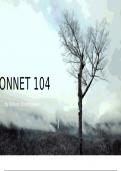ONNET 104
by William Shakespeare
,WILLIAM SHAKESPEARE (1564 –
1616)
We all know who Shakespeare is, but we need to learn a
bit
more about his sonnets:
Three key people appear in the sonnets:
The Dark Lady (possibly a lover, unlikely to be his wife)
The Rival Poet (likely Christopher Marlowe, who was
Shakespeare’s main competition)
The Fair Youth (possibly a lover; possibly a
“replacement son” for Shakespeare – remember that
his family did not live with him in London, and his son,
Hamnet, passed away at age 11; possibly a friend;
Shakespeare may have been a mentor to him…)
NB! Note the use of “possibly”…
,This sets the scene for the theme of The friend will never appear ‘aged’ to th
youth vs age, and beauty. speaker, as the affection/love is uncond
Elizabethan poetry: eyes are singled
Alliteration: Diction: Fair: someone’s beauty is described. Shakes
enhances the beautiful as well “Ocular proof” – being and seeing – use
imagery as the qualities of imagery frequently.
describing the a true gentleman. Figure of
‘fair friend’. Is said Homophon
to mimic the To me, fair friend, you never can be old, auditory pu
sound
Sensory of imagery
a sigh. aye (yes),
For as you were when first your eye I eyed,
(NOTE – used confirming
throughout Such seems your beauty still. Three winters cold friend’s fai
Sibilance:
poem!):
Have from the forests shook three summers’ pride, together w
SIGHT:
alliteration
TOUCH Imagery of seasons passing. NOTE: continued the sound
Your beauty has in next quatrain. Three years have passed REPETITIO
not changed since since they met. Partial personification of emphasis o
I met you (may winter. passing of
describe physical “Summer’s pride” refers to the flowers, leaves how his be
or character). and beauty of summer that changes with not change
Autumn and is stripped by Winter. Can we link also used i
the choice of “cold” and “pride” to the poet quatrain.
and the Fair Youth?
, Diction:
Beauteous =
beautiful,
especially to sight.
Diction: Process Three beauteous springs to yellow autumn turn’d
= natural cycle
or order of the In process of the seasons have I seen,
seasons.
Northern Three April perfumes in three hot Junes burn’d Sensory
hemisphere. Imagery
April = spring.
Since first I saw you fresh, which yet are green. SIGHT:
Natural blooming SMELL
new life/new Imagery: imagery of the seasons now extends to aging and t
flowers. youth. Where others are like summer flowers that are are “bu
June = summer. (i.e. they grow old over time), the Fair Youth remains “green”
Flowers wilt in of three years passing. “Green” links to youth and beauty. Can
the heat of link to youth in terms of inexperience and naivety?
summer NOTE: the beauty of the Fair Youth will also remain “green” b
(“burn’d”). has been written into the sonnet itself – he has been immorta
the sonnet. This idea carries through to the next quatrain.
,Volta: point of Simile: Beauty doesn’t seem to change
change. NB! This (move), like the hands on a clock/shadow on a Alliteratio
influences form sun-dial, it does. Similarly, when we see plosive sou
(more on this someone often, we don’t notice the process of hard.
later!) aging, though it happens. “m” = soft
Contrast in
Personification
of beauty – it Ah, yet doth beauty, like a dial-hand, reflect wha
thinks vers
moves and Steal from his figure, and no pace perceiv’d; reality?
changes
imperceptibly – it So your sweet hue, which methinks still doth stand,
“steals”.
Hath motion, and mine eye may be deceiv’d: Sibilance
Diction: echo the fi
“steals” stanza? A
implies an Diction: Diction: his Colon: sound? Or
illicit or “hue” = colour eyes have been indicates that more omin
secretive or shade deceived. the poet’s links to de
act. (blush of youth Logically, the concluding Sensory
Hidden = Elizabethan person has thoughts on Imagery:
from the beauty changed, but the matter will
poet. standard). he cannot (will follow.
not?) see it.
, Diction: “which” references the Tone: Diction:
previous stanza. For fear of his eyes commanding as generations
having been deceived… he instructs yet been bo
them. (i.e. those w
Alliteration: For fear of which, hear this, thou age unbred – would read t
supports the poem in the
tone. Ere you were born, was beauty’s summer dead. future).
Imagery: summer is the height of the seasons. “Beauty’s summer”, therefore,
references the height of beauty. i.e. the Fair Youth is the most beautiful person ev
When future generations are born, this season will be over (“dead”). i.e. when fut
generations live, the most beautiful person who ever lived will be dead, so they w
never know true beauty.
NOTE: here the poet resolves to believe that the Fair Youth will always remain bea
to him, in spite of the passage of time – he declares the beauty resolutely.
Hyperbole? Is the speaker exaggerating the beauty of the Fair Youth for effect, o
this how he genuinely feels?




